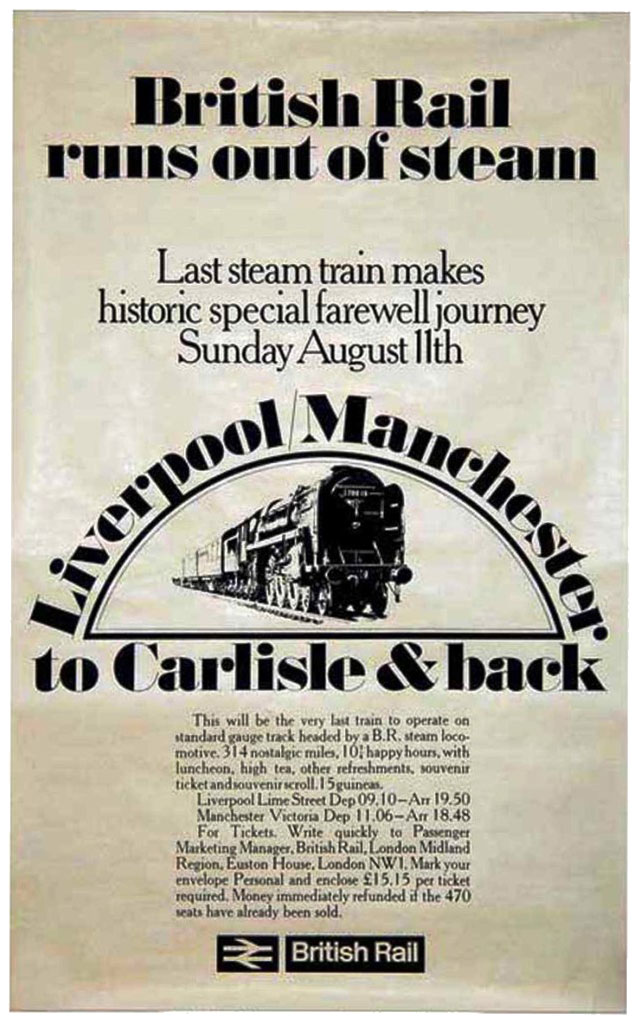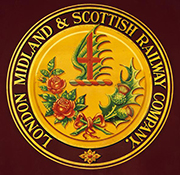

This site uses non-intrusive cookies to enable us to provide a better user experience for our visitors. No personal information is collected or stored from these cookies. The Society's policy is fully explained here. By continuing to use this site you are agreeing to the use of cookies.
Saturday the 11th of August 2018 marked the passing of half a century since standard gauge main line steam locomotive ceased regular service operations for British Railways. Although fifty years have passed, this historic event has certainly not been forgotten.
Sunday the 11th of August 1968 was indeed a momentous day in the history of British railway steam traction. After more than one hundred and fifty years of sterling service, steam locomotives were to be eliminated from main line services.
What saw out the end of steam? Was it a BR Standard, was it a Bulleid Pacific, an LNER A4, a GWR King or Castle? Yes to the first in the form a Britannia Pacific but no to all of the rest. In the main it was down to a trio of ex LMS Black Fives - the most work-a-day locomotives imaginable.

Back in 1968, advertisements in the press stated that a final commemorative run would take place on Sunday the 11th of August 1968. To quote the advertising poster:
"This will be the very last train to operate on standard gauge track headed by a BR steam locomotive, 314 nostalgic miles, 10¾ happy hours with luncheon, high tea, other refreshments, souvenir ticket and souvenir scroll, all for 15 Guineas. Money will be immediately refunded if the 470 seats have already been sold".
The schedule for this final run stated it would depart from Liverpool Lime Street at 09:10, hauled by Black Five locomotive 45110 and arrive at Manchester Victoria at 10:36. A change of motive power then would take place to Britannia Class locomotive 70013 Oliver Cromwell. Departure from Manchester Victoria was at 11:06, via Blackburn and the Settle and Carlisle Railway, arriving at Carlisle Citadel at 14:56. The return train was to depart at Carlisle Citadel at 15:30, hauled by two Black Five Locomotives, 44781 and 44871, arriving at Manchester Victoria at 18:48. After another change of motive power back to Black Five 45110, departure was at 19:02 and arriving back at Liverpool Lime Street at 19:50.
That was the proposed schedule anyway but this went completely astray due to a number of incidents on route. In fact this schedule could have won the 1968 Pulitzer Prize for outstanding fiction. The train's head code was 1T57 but this final excursion train became better known as the Fifteen Guinea Special due to the return ticket costing £15-15-00, (fifteen pounds and fifteen shillings), fifteen guineas or even £15.75 in metric type money that was still to come in the future. This may not seem a formidable sum today but it was quite a substantial amount of money in 1968.
The location chosen to see the train was Blackburn, Lancashire and this turned out to be quite a wise selection. On arrival at Blackburn Station, quite an audience had gathered at the southern end of the station. In those days the semaphore signals were controlled locally by a couple of signal boxes and plenty of advance warning was given of an approaching train. The signals cleared and the awaiting crowd, all with itchy shutter fingers, prepared their still and ciné cameras. However, the first train that appeared was a Brush Type 4 locomotive on a passenger train with a maroon ex LMS passenger carriage next to the locomotive. At this appearance, everyone put their cameras away. Well, not quite everyone. There was one lone exception. I wonder how many of these other people regretted their hasty decision later on.
The next train to appear was introduced well in advance by a shrill whistle and there was no doubt this was the train we were all here to see. Although Blackburn was not an advertised stop, stop it did as the locomotive was in need of a drink. Here was encountered one of the many incidents that befell this excursion. On stopping next to the water crane at the northern end of the station the fireman climbed onto the tender and attached the water bag and then turned on the water valve. Nothing much happened, the well was dry, there was no water! Now if this situation were to happen today, the service would have been declared a complete failure and a rail replacement bus service would have had to have been arranged.
However in the 1960's, railway men and in reality most people were permitted and did use their own initiative to get the job done. In those days there were no 'elf 'n' softie zealots to obstruct events by ordering "you can't do that". Very quickly the locomotive was uncoupled from the train and with the spirited assistance of the local signalmen; the locomotive ran round the train and sourced an abundant supply of water at the other end of the station. Once the locomotive was replenished, it then took its place once again at the head of the train. Very soon it was on its way to Carlisle, albeit somewhat delayed.
Although there was a police presence on the station, there was no restriction on standing line side at the approach to the tunnel or for that matter climbing signal posts for better photographic opportunities and everyone had the good old fashioned common sense to keep well clear of the through running lines. After the train's departure, Blackburn Station returned to its normal Sunday quiet self.
Some people waited for the return working and on its late appearance quite a few people had gathered at the southern end of the station. This gathering did not seem to have been anticipated by the local constabulary as only one single constable was on duty to maintain law and order. Unfortunately for the spectators this young constable did not take too kindly to anyone stepping off the platforms resulting in that opportunities for photography were somewhat restricted. Eventually though after some pushing and shoving, the ranks of the spectators broke and most people departed the confines of the platforms for a better view of the train from the line side, once again keeping well clear of the through running lines of course and finding a much better location for photography. This ideal location near to the signal box afforded a splendid view of the train as it departed and the overall scene was much more atmospheric due to the complete absence of irrelevant self appointed security minions in hi-vis tabards spoiling the scene. The constable, realising the futility of his situation was powerless to intervene.
So it came to pass that Black Fives 44871 and 44781 departed for Manchester Victoria. On arrival the two locomotives were removed and replaced with the original locomotive 45110 for the final segment of the excursion to Liverpool Lime Street. The end had finally come for main line steam traction in Britain.
The accompanying slide show using some of the photos I took that fateful day gives a flavour of the event. For more images from the final day of British Railways steam traction see:
http://www.eastbank.org.uk/uk_steam.htm
I wonder if anyone will, hopefully in the very near future, turn out to see the final run of a Pacer unit? I think not!
Allan Trotter.
All photographs on this page are copyright © Allan Trotter and used by permission.
Site contents Copyright © LMS Society, 2024

April 19th, 2024
Site contents Copyright © LMS Society, 2024